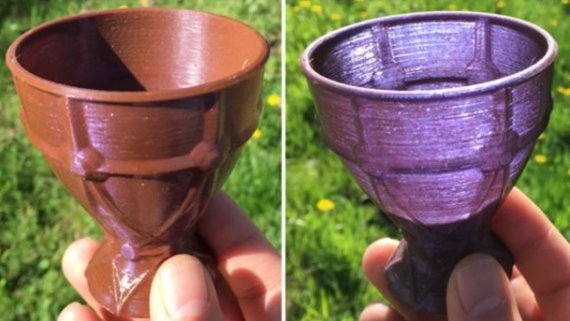Researcher Vittorio Saggiomo of the BioNano Technology chair group demonstrates the effect with the light on his mobile phone. He has an opaque, reddish-brown cup in his hand. But when he holds his light behind the cup, it suddenly turns purple and transparent. It looks like magic. The cup was 3D-printed in his lab, and changes colour with the position of the light source.
What Saggiomo is demonstrating is the dichroic (two-colour) effect of the material the cup is made of, a mixture of the polymer PVA (polyvinyl alcohol) and gold nanoparticles. The tiny chunks of gold reflect the light or let it through, depending on their size.
The discovery of this light effect of gold particles was made by Master’s student Lars Kool. During a minor on BioNano Technology taught by Saggiomo, he did an assignment that entailed making gold nanoparticles by reducing gold ions with citric acid. But he adapted the proportions of the ingredients in the instructions, which created the dichroic effect. Saggiomo then hit upon the idea of using the particles to make dichroic 3D-printed material.
Saggiomo printed the cup according to the Lycurgus cup from the British Museum. This cup from the 4th century is also dichroic and is coloured red or green according to the light. Here too, nanoparticles (gold and silver) are responsible for the effect. It is not clear whether this effect happened to be coincidental or based on refined craftsmanship.
The bicoloured effect occurs with a particular proportion of gold to citric acid solution. The gold chunks that are then formed are 50 to 60 nanometres in size and oval in shape. It is a simple and, what is more, cheap procedure. Kool: ‘Gold is expensive, but the concentrations we use are very low. There is much less gold in the cup than in a mobile phone.’
Saggiomo envisages plenty of applications for the use of gold nanoparticles in 3D printing. ‘For example, you can make lenses with it that allow light through selectively. You can use the effect in solar panels to allow light through. Or you can use those nanoparticles in sensors.’ Lars Kook hopes to graduate in the autumn and would like to continue working on his discovery as a PhD student.’

 Photo: Vittorio Saggiomo
Photo: Vittorio Saggiomo